2.
GHANA
Commercial bank interest rate investigation
A storm has been brewing in parliament over the official
inflation figures. The figures from the Ghana Statistical
Service put May inflation at around 8.% (down on the
previous month) but some prominent members of
parliament have questioned how inflation is reportedly
dropping while there is ample evidence of price inflation.
Part of the problem stems from the disparity between the
Bank of Ghana (BOG) base rate and the average interest
rate charged by commercial banks. The BOG¡¯s current
base rate is around 13 percent but the average interest rate
of commercial banks is said to be around 25 percent.
The country¡¯s lawmakers have decided to probe the issue
of the difference between the BOG¡¯s base rate and the
interest rates of the various commercial banks operating in
the country as it seems that high interest rates are
hindering development of small enterprises especially in
the agriculture and forestry sectors.
Highway construction discussed with Chinese banks
Officials from the Economic Community of West African
States (ECOWAS) have started talks with China seeking
investors for the agricultural and industrial sectors and for
investments in physical infrastructure.
The ECOWAS delegation is scheduled to hold talks with
representatives of the Export-Import Bank of China and
the China Development Bank on possible support for
infrastructure projects seen as supporting the economic
integration of West African states.
Media reports indicate that Ghana and Sierra Leone are
asking the Export-Import Bank of China for an investment
of US$320 million for the construction of a highway
network linking the countries.
Call to guard against forest Degradation.
The National Forestry Forum of Ghana (NFF) has stated
that the time has come for government, to curb forest
degradation by taking tough action to combat illegal
logging and illegal mining activities in the country¡¯s
forests.
In an address the vice president of the NFF, Mr. Kwame
Asamoah-Dwomoh, called on the government to tighten
procedures for the allocation of land for mining and also
put in place new strategies to curb illegal logging before
the situation gets out of hand.
The NFF advised government to do more to reverse the
loss of forest cover through sustainable forest management
and to prevent forest degradation.
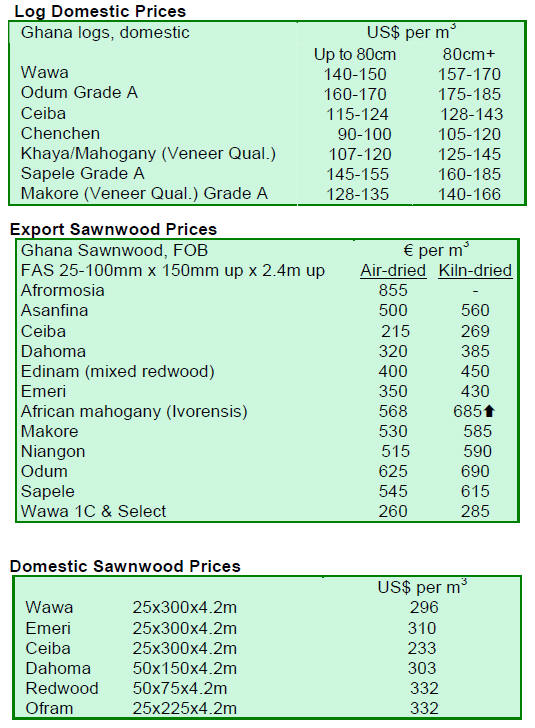
3.
MALAYSIA
New homes out of reach for young workers
Prices of residential housing in Malaysia have increased to
a point where they are almost beyond the reach of many
young working adults, says an analyst.
Increased ferrous and non-ferrous commodity prices and
increases in the costs of other construction materials such
as cement and roofing tiles over recent years is one of the
main contributory factors. Estimates put the cost of
construction at around 70% of the total cost of a property
with land cost accounting for the balance 30%.
Construction grade sawn mixed hardwood prices have
risen and formboard plywood for poured concrete work
costs RM1,290 per cubic metre, up from the RM820 per
cubic metre seen in the recent past.
Steel bars could constitute up to 20% of construction cost,
while concrete account for 15% and other masonry works
account for 10% of the cost. The cost of construction
materials has increased by no less than 70% in the last 5 to
6 years in Malaysia.
Analysts suggest that the price difference between
domestic and export quality sawnwood and panel products
such as plywood will continue to narrow substantially over
the rest of the year.
ome timber traders are of the opinion that selling to the
local construction industry may now be more attractive
and profitable than exporting, especially as the EU debt
crisis and economic uncertainty in the US continues to
bear on the market.
Latex prices steady so no change in rubberwood prices
The price of rubberwood sawnwood is unchanged as the
prices of crude rubber latex remains stable so there is no
incentive for plantation owners to fell and replant rubber
plantations. The main market for latex is the automobile
and aircraft tyre industry. Both industries are still very
much in the doldrums due to weak global demand.
Clearing of redundant oil palm plantations underway
The current dry weather is providing oil palm plantation
owners the opportunity to replant. The clearing of
redundant and old oil palm trees is also creating much
needed raw material for panel product manufacturers.
Analysts report that the trade is not expecting export prices
of plywood and other panel products to vary much over
the next few months.
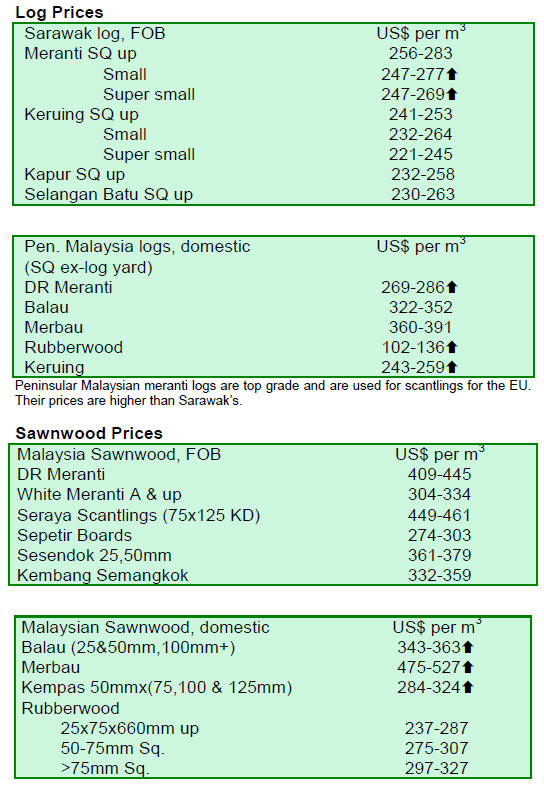
4.
INDONESIA
Bali furniture exports edge up
The Indonesian province of Bali, better known for
tourism, reported that its furniture exports had edged up to
US$13.4 million for the first four months of 2011.
Furniture exports accounted for around 8% of Bali¡¯s
total
exports for the period. The export of furniture is one of the
14 major export products for the province.
Competition eating into Indonesia¡¯s market share
The Indonesian Chamber of Commerce has expressed
concern that Indonesia is losing market share in its trade
with the EU. It added that stiff competition from China,
India, Thailand and Vietnam is cutting into Indonesia¡¯s
market share in the EU market.
Meanwhile, on the same note, Indonesia and the EU have
agreed to commence negotiations that will lead to a free
trade agreement (FTA) between the two.
The EU is currently undertaking similar negotiation
with
several other Asian countries, including Japan, Singapore
and has just concluded an FTA with South Korea.
The EU negotiating team has handed a list of
recommendations to Indonesia for the negotiation of a
Comprehensive Economic Partnership Agreement
(CEPA). The FTA is expected to cover up to 95% of tariff
lines and trade values over a period of nine years.
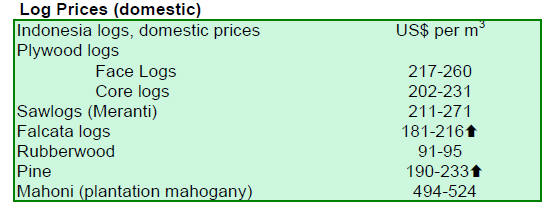

5. MYANMAR
Brisk trade in Gurjan
The demand for Pyinkado remains very subdued while, as
was the situation last month, demand for Gurjan (Kanyin)
is very brisk.
Trade analysts suggest this is, in part, due to
price factors.
Because of its popularity Pyinkado prices have been rising
steadily over the past months whereas prices for Gurjan
have not moved up at the same rate.
The Teak market remains generally stable despite the
past
price increases.
Strong Kyat not helpful to the timber industry
The timber industry, along with other sectors of the
economy, has had to adjust to the recent upsurge in the
value of the Myanmar Kyat against the US Dollar.
The highest and lowest Kyat values against the
Dollar are
as follows:

A strong Kyat is not helpful to the timber industry
in
exporting wood products however, as analysts point out,
this may not effect in the resale of teak logs in the export
markets as this is all effected in hard currencies.
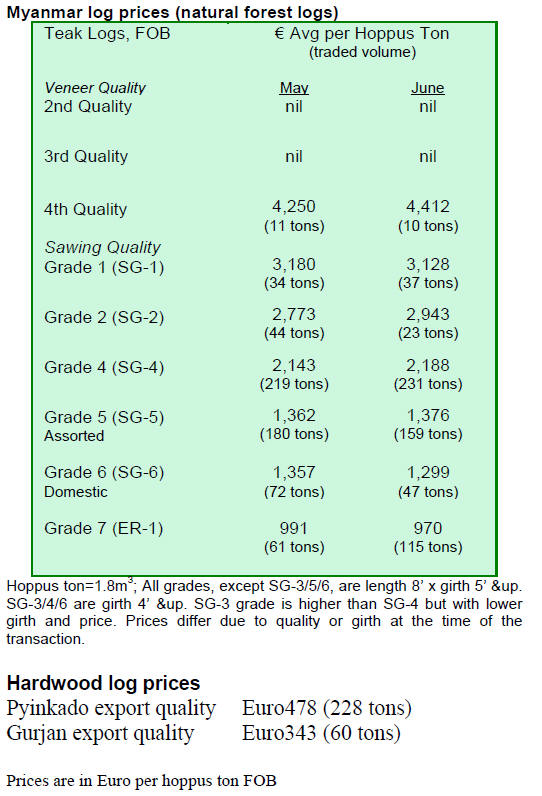
6. INDIA
Indian industry going for automation
In India, both wood raw materials and now labour are now
in short supply. Because labour was cheap in India the
timber industry developed using labour intensive
production processes.
Today however, the situation is different and
because low
cost labour is no longer readily available many factories
are running at around only 60% of their capacity.
To overcome this persistent problem the industry now
prefers to have as much automation as possible and is
retooling production plant accordingly. This change is
driving up demand for high tech wood processing
equipment.
Trade levels continue to surge
Exports from India surged over 50% during May reaching
as high as US$25.9 billion at the same time imports were
also up over 50% reaching US$ 40.9 billion compared to
the level in May last year.
Renewed licenses for closed sawmills
With a view to conserving and rationalising the
consumption of wood, the Supreme Court of India had
issued rules and guidelines on forest harvesting and the
State governments had strictly followed these. As a result,
many companies which did not meet the requirements of
the new rules had to close with the loss of many jobs.
The good news from Gujarat is that 265 mills
producing
lumber and veneers which had to cease operation because
of the State rules have been granted new operating
licenses.
Scheme to increase imports of timber through
Kochi
The supply and distribution of logs to processing mills is
satisfactory and this has supported the market demand in
Mumbai, Kandla, Mangalore and Tuticorin.
Efforts are being made to increase imports of timber
through Kochi and the Port Trust Authorities of Kochi
have introduced schemes offering discounts on timber in
storage.
Presently, Kochi is reported to be handling 60,000
tonnes
of timber as against 550,000 tonnes being handled by
Tuticorin.
The news that Kochi port will be further developed
is a
good for the timber industry and could increase the
handling of teak logs and other wood products at Kochi.
Satisfactory break of monsoon aids tree planting
programmes
The South West Monsoon is the major lifeline for Indian
agriculture and for re-forestation programmes undertaken
by all states in the country. The uniform end of this year¡¯s
monsoon across the country is seen as foretelling good
crops and steady prices.
Reports of massive tree planting pouring in.
Karnataka had
made ready 10 million saplings to be planted during this
season. Gujarat is next with roughly the same number of
saplings being made available.
All states and environmental and community
organizations
have ambitious programmes to plant trees on a large scale.
This is good news for the environment and large scale
plantations are needed by industry as there is a chronic
shortage of wood raw materials in the country.
Plantation teak prices C&F Indian ports remain
unchanged.

Demand from Europe, USA and Middle East for teak and
other hardwoods remains steady.
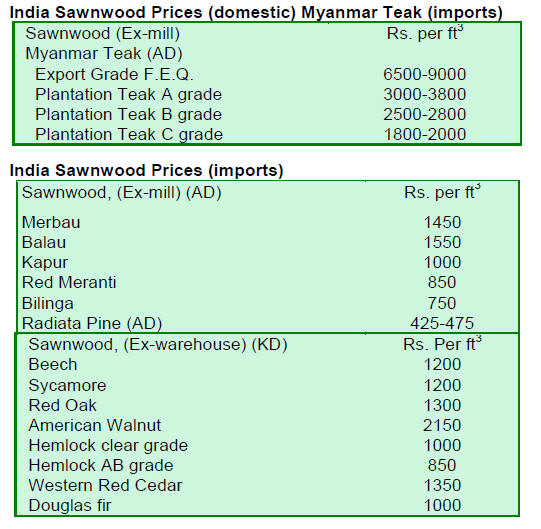
7. BRAZIL
Only pine sawnwood exports expand
In May 2011, exports of timber products (except pulp and
paper) fell 2.7% compared to values in May 2010, from
US$ 226 million to US$ 220 million.
Exports of tropical sawnwood declined both in
volume
and in value, from 44,400 cu.m in May 2010 to 33,100
cu.m in May 2011 and from US$ 21.2 million to US$ 17.5
million, respectively, over the same period. This
performance corresponds to a 17.5% decline in export
value and a decline of 25.5% in export volume.
Exports of tropical plywood dropped from 9,300 cu.m
in
May 2010 to 6,500 cu.m in May 2011, representing a 30%
decline. In value terms a 20% decrease was registered as
exports fell from US$ 5 million to US$ 4 million.
In contrast pine sawnwood exports increased 22.4%
in
value in May 2011 compared to the same month in 2010,
from US$ 13.4 million to US$ 16.4 million. In volume
terms, exports increased 17.8%, from 59,500 cu.m to
70,100 cu.m over the period.
Pine plywood exports dropped 2.4% in value in May
2011
compared to the same month of 2010, from US$ 37.2
million to US$ 36.3 million. Export volumes fell 5.2%
during the same period, from 100,300 cu.m to 95,100
cu.m.
The value of exports of wooden furniture dropped
from
US$ 52.2 million in May 2010 to US$ 44.2 million in May
2011, representing a 15.3% drop.
Real continues to appreciate against dollar
The average exchange rate in May 2011 was BRL1.61 per
US dollar whereas it was BRL1.81 to the dollar in May
2010 illustrating the sharp appreciation of the Brazilian
currency against the US currency.
The Brazilian Consumer Price Index (IPCA) of May
fell
0.3% compared to the level in April and the accumulated
IPCA for the first five months of the year was 3.71%, a
0.62% increase compared to the same period in 2010
(3.09%).
Inflation risk drives up interest rates
Brazil¡¯s Central Bank increased the prime interest rate
(Selic) by 0.25% bringing the rate to an annualized
12.25%. This increase was anticipated as inflation has
been rising and could breach the inflation target of 4.5%
for if no action was taken.
However, forecasts suggest that inflation, as
measured by
the Consumer Price Index (IPCA) shows a yearly trend
close to 6. % plus.
Workshops to strengthen community forest
management
Natural forests can generate profits and based on this
premise the Brazilian Forest Service (SFB) has arranged a
capacity-building workshop (the first of the four
scheduled) for participants from civil society and
community leaders involved in community forestry in the
regions of Transamazonian and Xingu River.
The forest management practices of today are
adequate to
maintain the potential of the forest generating income for
local populations but, say the SFB, many are not aware of
this.
One of the biggest problems in the Amazon region is
that
of land tenure. Many of the social, environmental and
ownership conflicts that occur in the region stem from
problems relating to land titles.
The goal of the SFB workshops is to help
participants in
the evaluation of community organizations such as
cooperatives and associations to identify where they can
be improved.
The objective of SFB is to help strengthen the
region's
forest economy, valuing its resources and providing
technical capacity that these communities need to achieve
their goals.
According to the SFB, in case of the Altamira
region,
efforts have been concentrated on the forest valuation and
sustainable harvesting.
Timber movement control technology transfer to
other ountries
The Brazilian computerised system for data recording in
timber operations and trade called ¡°Document of Forest
Origin¡± (DOF) will be shared with other Latin American
countries and also with South Africa, China and Russia
according to the Brazilian Institute of Environment and
Natural Resources (IBAMA).
This technology has replaced the former Forest
Products
Transport Permits (ATPF) in Brazil which were frequently
falsified.
The Brazilian system is considered a world best and
if the
interest of various countries is confirmed, Brazil will
transfer the system through technical cooperation to those
interested.
According to IBAMA, the advantage of the DOF system
is
decentralised monitoring of the entire chain of custody of
timber from the forest to first processing.
The legal timber trade in Brazil amounts to around
BRL
15 billion annually with most production originating in
Para, Mato Grosso, Rondônia and Maranhão states.
The Amazon Cooperation Treaty Organization (ACTO)
is
encouraging its member states, such as Peru, Ecuador,
Colombia, Venezuela, Guyana and Suriname to adopt the
DOF system. Reports indicated that Bolivia has already
signed a cooperation agreement with Brazil for use of the
system.
Mechanisms to promote development of forestry
sector
The Heads of State and governments of tropical forest
basins of the world agreed on June 3 to continue
strengthening relationships to emphasize their common
interests in regional and multilateral fora on forests,
biodiversity and climate change.
The decision is part of the "Brazzaville
Declaration"
adopted at the end of the summit of member countries of
forest basins of the Congo (Africa), the Amazon (Central
America) and Borneo-Mekong (Southeast Asia) held in
the Republic of Congo.
Having analysed the relationship between
deforestation,
forest degradation and socio-economic problems the
participating countries recommend cooperation to
eliminate actions that encourage destructive exploitation
of the forest.
They agreed to establish mechanisms to promote
development of the forestry sector, encouraging the green
economy for development of low carbon and reducing
poverty in member countries. They also advocate
additional funding, sustainable and transparent to allow
countries to meet the challenges of sustainable forest
management and to respect their commitments on forests.
The creation of new public-private partnerships was
recommended to facilitate investment in the forestry sector
oriented towards development.
Brazil participated in the summit with other Latin
American parties such as Bolivia, Colombia, Ecuador,
French Guiana, Guyana, Peru, Surinam and Venezuela.
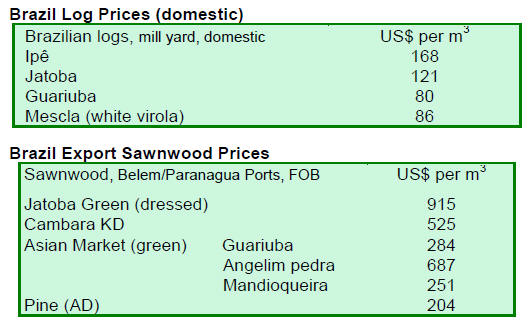

8. PERU
Approved Forestry and Wildlife law
The Congress of the Republic overwhelmingly approved
the new draft Forestry and Wildlife law which establishes
the legal framework for the conservation, protection and
sustainable use of forests in the country.
In emphasising the importance of this step for the
sustainable development of forest resources and wildlife in
the country, the president of the Agrarian Commission,
Anibal Huerta, said the new draft was prepared after
meetings and public consultations between the
government and rural and indigenous communities.
The latest ruling approved the creation of a new
the
authority called the Forest and Wildlife Service (Serfor),
which replaces the current Forest and Wildlife Department.
FTA with neighbours about to be concluded
Peru is currently negotiating free trade agreements with
Panama, Guatemala and Costa Rica, three of the five
Central American countries with which the country trades.
Reports suggest that it is possible that agreement
will be
reached soon but this depends on completing the work that
remains to be done in the DOHA round of negotiations.
The outstanding issue to be resolved to achieve the
completion of negotiations involve the exclusion of some
agricultural relief programmes amongst other issues.
Panama is currently the fourth largest importer of
wood
from Peru and the main importer of wooden furniture from
the country.
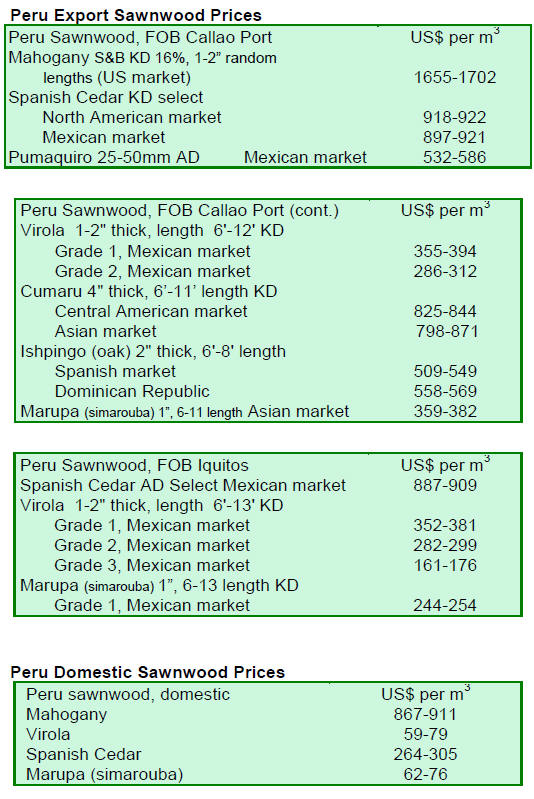
9. BOLIVIA
Forest product exports increase
Forest products exports comprising timber and non-timber
items from January to April increased by 8.4% compared
with the same period last year.
Export earnings rose from US$ 64 million in 2010 to
US$
69.7 million this year. Manufactured wood products and
Brazil nuts accounted for around 83% of the total exports
of forest products. The balance of exports was made up of
semi-finished wood products.
The U.S. market remains the main buyer of Bolivian
wood
products accounting for US$ 19 million or almost 30% of
the total. The United Kingdom followed with trade
amounting to US$ 8.9 million (14% share) and the
Netherlands with US$ 4.8 million (7.5%). Other major
markets were Argentina and China.
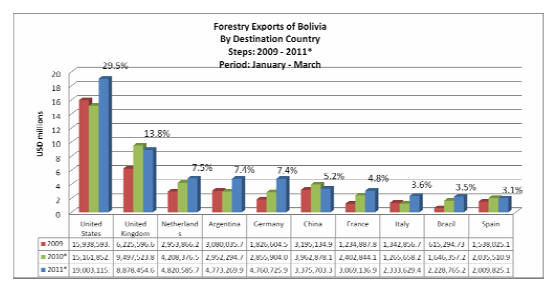
10.
GUYANA
Greenheart log prices reverse direction
For the period under review log prices were very
favourable. Greenheart logs of all sawmill qualities
secured price increases during the past two weeks, in sharp
contrast to the situation some weeks ago.
Purpleheart log prices were stable except for small
sawmill quality logs which saw a rise in price as against
prices in the previous fortnight.
Mora log prices also improved slightly over the two
week
period under review.
Sawnwood prices slip marginally
Sawn lumber prices were mixed. Some items, including
undressed Greenheart (select) quality recorded a marginal
decline in its top-end price from US$ 848 to US$ 740 per
cubic metre and undressed Mora (merchantable) quality
also saw a decline in prices for this fortnight period.
On the other hand, prices for undressed Purpleheart
(select) rose from US$ 750 to US$ 875 per cubic metre.
Dressed Greenheart prices fell slightly from US$
890 to
US$ 818 per cubic metre; similarly dressed Purpleheart
also recorded a marginal decrease in price from US$ 975
to US$ 912.
Splitwood prices remain firm and reached as high as
US$976 per cubic metre on the export market for this
fortnight period.
Roundwood piles attracted buyers in Europe and
North
America and fetched good prices.
Prices for Guyana¡¯s Ipe (Washiba) continue to hold
firm at
around US$ 2,350 per cubic metre on the export market.
Plywood exports resume
Plywood was exported during the period under review
with BB/CC grades fetching as much as US$640 per cubic
metre. The main destination for this plywood was
neighbouring countries in South America.
Guyana and Republic of Congo to cooperate on
forestry
Guyana has signed an agreement with the Republic of
Congo to increase cooperation between the two countries
in the fields of forestry and wood industries.
The Memorandum of Understanding, covering a five
year
period, was signed by Guyana¡¯s Agriculture Minister
Robert Persaud and Congolese Minister of Forestry and
Sustainable Development Henri Djombo.
This agreement will see the two countries
establishing and
developing cooperation to address sustainable forest
management, REDD+ initiatives and the enhancement and
development of processed wood and wood-based
construction industries.
Recognising the importance of sustainable
utilisation of
forest resources for the economic and social development
of the two countries which boast large areas of pristine
rainforest, bilateral cooperation in technical, industrial and
managerial aspect of the forest industry will significantly
enhance the development of the two countries.
Other initiatives will include exchange visits by
delegations from the two countries and exchange of
information on science and technology relating to forest,
tree seedlings, genetic material and other forest resources.
It will also see other group studies and human
resource
training and collaboration in research and production and
joint surveys. The two countries will also explore trading
in timber and other forest products and the training of
technicians and other experts in forestry related
disciplines.

Related News:
¡¡